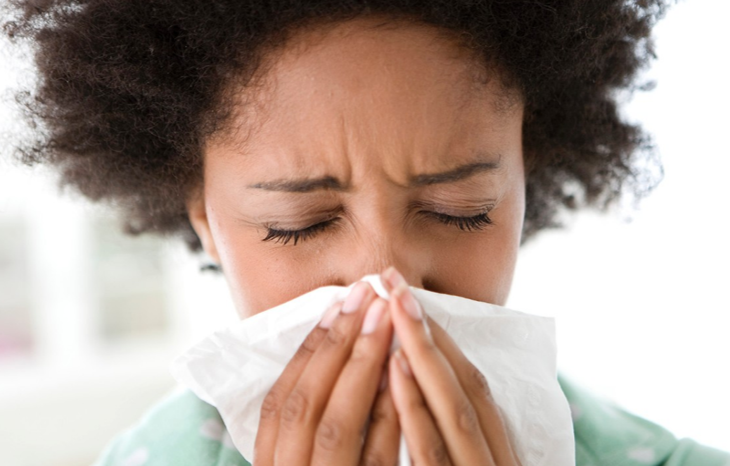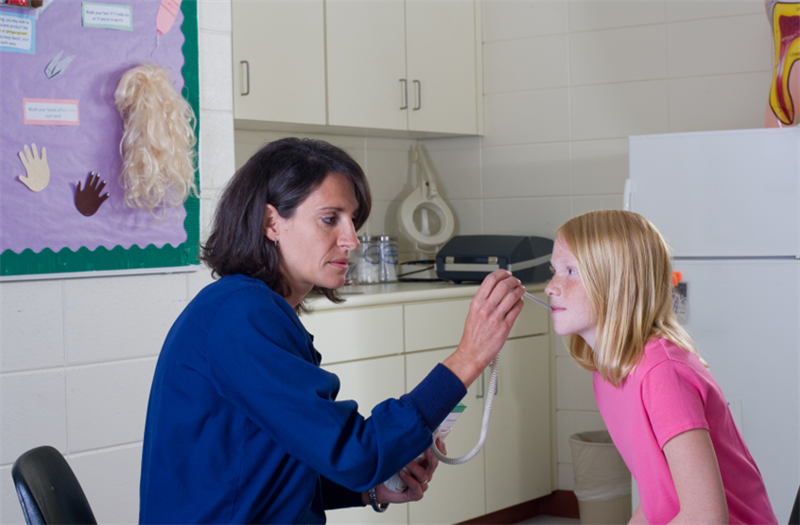Tips and tricks on how to avoid illness during the influenza season.
View as PDF
View this email on our site
Subscribe to this newsletter

We wish our readers a Happy New Year 2020!
Please consider distributing this newsletter within the state of Arizona. If you work in education please let us know if you send this on to anyone in the following groups: school staff, faculty, students, and/or parents and guardians.
Unfortunate Facts about Flu (Influenza Viruses)
Dawn H. Gouge, Shaku Nair, and Shujuan (Lucy) Li,
University of Arizona
While these statistics sound alarming, the number of deaths due to pneumonia and influenza are relatively low compared to some years, the hospitalization rate is similar to previous years at the same point in time, and data from clinical laboratories indicates a reduction in the number of influenza positive specimens sent in for testing this week.
However, flu is still widespread in most states, and it is not too late to get vaccinated.
Influenza viruses circulate in the U.S. each year, most commonly from late fall through early spring. Flu is generally considered to be more serious than the common cold for children, and each year millions of children get sick with seasonal flu, and tragically, some die from flu-related complications.
Most people recover without experiencing serious complications. However, serious illness is more common among the elderly, young children, pregnant women, and persons with certain chronic medical conditions (including cardiovascular disease, pulmonary disease, diabetes and Addison’s disease). Ask your medical care provider if you or someone you care for are in a high-risk category.
Influenza illness is a common cause of missed work, both directly due to adults missing work, and indirectly due to adults who are home caring for dependents. One analysis of 2012-2015 school absentee data found that influenza accounted for 39% of illness episodes in school and 47% of missed days (McLean et al., 2017). The CDC and CDC Advisory Committee on Immunization Practices has recommended annual influenza vaccination for everyone 6 months and older, who do not have contraindications since 2010.
It is ideal to get a flu vaccine before flu begins spreading in your community. It takes about two weeks after vaccination for antibodies that protect against flu to develop in the body. The CDC recommends that people get a flu vaccine by the end of October, but getting vaccinated later, can still be beneficial, even in January or later.
The CDC has published “Prevention and Control of Seasonal Influenza with Vaccines, 2019-20” for health professionals so please make sure your school and community medical staff have access to this information
https://www.cdc.gov/flu/professionals/acip/index.htm.
Although flu comes every year, the health impacts differ depending on when, and which strains are circulating. In recent years, flu related deaths have ranged from a low of about 3,000 to a high of about 49,000 people per year. Hospitalizations also range between 140,000 and 710,000 annually (CDC). During 2012-2013, about 45% of the U.S. population were vaccinated, helping to prevent an estimated 6.6 million flu-related illnesses.
Although flu comes every year, the health impacts differ depending on when, and which strains are circulating. In recent years, flu related deaths have ranged from a low of about 3,000 to a high of about 49,000 people per year. Hospitalizations also range between 140,000 and 710,000 annually (CDC). During 2012-2013, about 45% of the U.S. population were vaccinated, helping to prevent an estimated 6.6 million flu-related illnesses.
-
Fever (not everyone with flu will have a fever)
-
Chills
-
Cough
-
Sore throat
-
Runny or stuffy nose
-
Muscle or body aches
-
Headaches
-
Fatigue (tiredness)
-
Some people may have vomiting and diarrhea, though this is more common in children than adults.
Any person experiencing chest pain or breathing complications
should seek immediate medical assistance.
The flu can also exacerbate (make worse) chronic health problems like asthma
and chronic obstructive pulmonary disease (COPD).
Most people recover completely within two weeks, but some develop complications, such as pneumonia. Pneumonia in very young children or in adults older than 65 is cause for concern as the symptoms can become life threatening, and may result in death if left untreated. Bronchitis, sinus and ear infections are other common complications resulting from the flu virus. Influenza antiviral drugs may be prescribed to treat influenza infections.
Antiviral drugs are a second line of defense that are used to treat flu if you get sick. Remember, your first line of defense is your annual flu vaccination.
FDA approved medications are prescribed by your doctor and outpatients with acute uncomplicated influenza may be prescribed: oral oseltamivir, inhaled zanamivir, intravenous peramivir, or oral baloxavir. The American Academy of Pediatrics advocates for the routine use of influenza vaccines and antiviral medications in the prevention and treatment of influenza in children 6 months or older and without medical contraindications during the 2019–2020 season
(https://pediatrics.aappublications.org/content/144/4/e20192478) .
So how can caregivers and facility managers maintain healthy indoor environments, and limit the spread of the flu virus? Flu viruses spread from person to person mainly by droplets made when people with flu cough, sneeze, or talk. Less often, people might get the flu by touching a contaminated surface or object, and then infect themselves by touching their own mouth, eyes, or nose. Most healthy adults are capable of infecting other people 1 day before symptoms develop, and up to 7 days after becoming sick. Children may pass the virus for longer than 7 days. Symptoms start 1 to 4 days after the flu virus enters the body.
This means that you are able to pass on the flu to someone else before
you feel sick yourself
Good health habits minimize flu:
-
Stay home from work, school, and errands when you are sick. This will help prevent others from catching your illness. Managers please support staff who need to stay home.
-
Avoid close contact with people who are sick or who have chronic illnesses. Teachers and staff managers, please accommodate students and workers keeping up with schoolwork or work projects from home as much as possible.

-
If you are ill cover your nose and mouth with a tissue when you cough, sneeze
or talk. Throw the tissue away immediately after use and wash your hands with soap and water. If a tissue is not available, cover your mouth and nose with your sleeve, or the crook of your elbow. This has been named the “vampire sneeze”, and catches on well with young children. If you cover your mouth and nose with your hands, wash them immediately.
- Wash your hands often with soap and water, especially after you cough or sneeze. Give children the opportunity to wash their hands and encourage children to wash their hands effectively: 1) Rinse hands and arms up to the elbows, 2. Apply soap and lather for at least 20 seconds (sing the Happy Birthday song twice) cleaning hands, arms, and fingernails, 3. Dry with a paper towel. NEVER have children use disinfectant wipes as hand sanitizer wipes, these are two very different things.

-
Avoid touching your face, especially eyes, nose, or mouth. Encourage children to avoid touching their own or others’ faces.
- Clean and disinfect surfaces or objects. This is a job for adults, who can accurately use products correctly following all the steps necessary as provided on the label
Five important things to know as you combat the flu
- Know the difference between cleaning, disinfecting, and sanitizing.
- Cleaning removes some germs, debris, and dirt from surfaces or objects. Soap and water significantly improves the physical removal of germs from surfaces.
- Disinfecting kills germs on surfaces or objects. Disinfecting alone will not clean dirty surfaces but disinfecting after cleaning further lowers the risk of spreading infectious germs. Disinfectant wipes are registered pesticides as they are designed to kill, or inactivate microbes.
- Sanitizing lowers the number of viable germs on surfaces or objects to safe levels, determined by public health requirements.
When addressing pathogens in the built environment, select the cleaning product based on the need. While soapy water is sufficient to clean up a drink spill, it is not the best option for all jobs, for example, a disinfectant is required to clean wrestling mats to prevent the spread of infectious skin diseases like ringworm (a fungal infection of the skin). Remember that disinfectants are registered pesticides and therefore the label must be followed in order to avoid health problems, such as eye injuries, chemical burns, and respiratory illness, as well as to achieve effective disinfection.
During influenza season school teachers sometimes appeal for disinfectant wipes and tissues. While it is enormously helpful to supply the latter, disinfectant wipes are not ideal for school classrooms for several reasons:
- School aged children should NOT be touching them. KEEP OUT OF REACH OF CHILDREN is on the container.
- They are sometimes used as hand and even face wipes by children, and many contain eye irritants as well as respiratory irritants that affect asthmatics.
- Disinfectant wipes are registered pesticides as they are designed to kill, or inactivate microbes. People should use gloves, or at least wash their hands after using them.
- Clean surfaces and objects that are touched often.
- Daily sanitize surfaces and objects that are touched often, such as desktops, countertops, door handles, computer mouse and keyboards, faucets, and phones.
- Use gloves when handling surfaces and items contaminated with bodily fluids, and throw soiled items away after proper disinfection when appropriate.
- The flu virus can remain in an infectious form on a surface for up to 48 hours. It is not necessary to close work places, childcare facilities or schools to clean or disinfect because of flu. If facilities are closed due to staff shortages or student absenteeism during a flu outbreak, it is not necessary to do extra cleaning and disinfecting. The passage of time and normal cleaning and disinfection practices are sufficient to remove or kill flu viruses.
- Always follow label directions on cleaning products and disinfectants.
- Wash surfaces with a detergent to remove dirt.
- Rinse with water.
- Apply an EPA-registered disinfectant that is approved to kill influenza virus, following label directions exactly. Disinfection usually requires the product to remain on the surface for a certain period of time (e.g., letting it stand for 3 to 5 minutes), and may need to be removed with clean water. Follow label directions exactly.
- Understand product safety warnings.
- Products have specific directions on labels and hazard warnings. Chemically protective gloves and eye protection is advisable and may be legally required if stipulated on the label.
- Never allow children to use disinfectants or disinfectant wipes.
- Do not mix detergents with disinfectants unless the label explicitly states that it is safe to do so. Combining products can result in serious injury or death. Mixing chlorine bleach and ammonia cleaners produces a lethal chlorine gas. Commonly used products contain bleach (hypochlorite) and ammonia e.g., toilet bowl cleaners often contain bleach, and window cleaners often contain ammonia.
- Ensure that anyone using cleaners and disinfectant products have access to product labels in a familiar language, and have read and understand the labels.
- Know how to handle solid waste.
- Follow standard institutional procedures for handling waste, which may include wearing gloves. Place no-touch wastebaskets where they are easy to use. Avoid touching used tissues when emptying wastebaskets, or wear gloves if tissues must be handled. Wash your hands with soap and water after processing waste and dispose of gloves.
- Stay home if you are a sick and work as a food handler. Influenza viruses from sick food workers can contaminate food if workers do not wash their hands properly, cough, sneeze, or talk over food that will not be cooked (e.g., salads or sandwiches). People who eat contaminated food can then get sick.
Helpful resources
Citation
McLean, H. Q., Peterson, S. H., King, J. P., Meece, J. K., Belongia, E. A. 2017. School absenteeism among school-aged children with medically attended acute viral respiratory illness during three influenza seasons, 2012-2013 through 2014-2015.
Upcoming Events
Save the Date: April 28th, 2020, Tuesday, 7:30am - 5:00 pm. 3rd Arizona School IPM Conference Carl Hayden Community High School, 3333 W Roosevelt St, Phoenix, AZ 85009. Details coming soon! The Arizona School IPM Conference is a great opportunity for continuing education, professional development and awareness building; a day of engaging presentations and hands-on activity, for all persons involved with schools, childcare and similar facilities in Arizona; and anyone with an interest in ensuring safe, healthy learning and working environments. There will be separate tracks for indoor and outdoor environments. Listen to talks by experts on various aspects of school IPM, share your experiences and questions with your peers, discuss strategies and find solutions to pest issues your school is facing. Give feedback on topics you would like to see in future events. Details coming soon!
Upcoming Integrated Pest Management Webinars
EPA Webinar on Bed Bugs in Multi-Family Housing and Dorms: A Panel Discussion
Tuesday, January 14, 2020
EPA is hosting a panel of experts you can tap into to address your questions and concerns about managing bed bugs in multi-family housing and dorms. This topic continues to be of great interest when diving into the challenges posed by bed bugs and the actions we can take to prevent and manage them using integrated pest management. Participants will be able to pose questions to university-affiliated experts along with representatives of the Department of Housing and Urban Development.
Register at: https://register.gotowebinar.com/register/22123675854588419
EPA Webinar on New Tick Threats and Controls: A Panel Discussion
Tuesday, February 4, 2020
This webinar will feature a panel discussion dedicated to the growing threat posed by ticks and new control tactics to address this expanding pest. Webinar participants will be able to pose questions, in real time, to a panel of entomologists and other related experts who understand the health concerns posed by ticks to individuals and their pets. Seize on this opportunity to ask experts about the newest tick prevention and control measures.
Register at: https://register.gotowebinar.com/register/1996543094261897475
EPA Webinar on Creating Monarch Habitats in Schools and Communities
Tuesday, March 10, 2020
Monarchs are important pollinators and securing habitats for them is a critical component to the overall ecosystem. Attend this webinar to learn about the threats to the monarch butterfly, migration trends, and the role we can play in conserving their habitats by adopting integrated pest management practices. Presenters will discuss how schools can create a living educational environment that provides a safe habitat for monarchs.
Register at: https://register.gotowebinar.com/register/1491497821206849027
For more information about the EPA Schools program, visit: http://www.epa.gov/schools/
To view all our previous newsletters, visit: https://acis.cals.arizona.edu/community-ipm/home-and-school-ipm-newsletters
Acknowledgements
This material is in part funded by the National Institute of Food and Agriculture, U.S. Department of Agriculture, under award number 2017-70006-27145 that provides Extension IPM funding to the University of Arizona. Additional support is provided by the U.A. – Arizona Pest Management Center.





